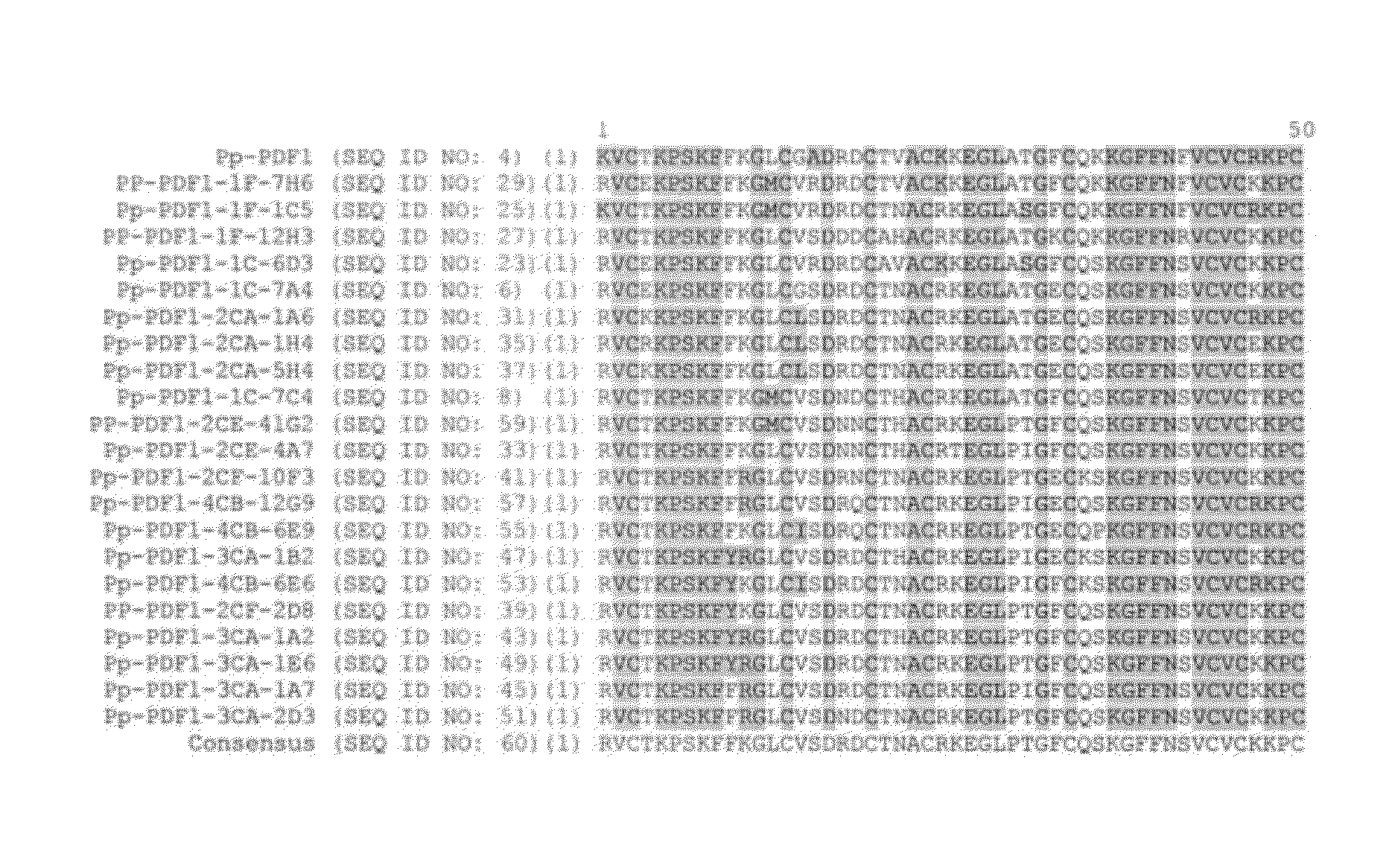Defensin variants and methods of use
a technology of defensin and variants, applied in the field of polynucleotides and polypeptides with antipathogenic activity, can solve the problems of huge annual losses of marketable food, fiber and feed, serious limitation on agricultural productivity, etc., and achieve the effect of improving the antipathogenic activity
- Summary
- Abstract
- Description
- Claims
- Application Information
AI Technical Summary
Problems solved by technology
Method used
Image
Examples
example 1
DNA Shuffling
[0317]Gene shuffling utilized coding sequence of Pp-PDF1 mature peptide. Limited diversity was introduced from related defensin sequences by spiking of synthetic oligonucleotides into the shuffling (assembly) reactions. The amino acid changes that contributed to improved activity are the serine residues at positions 36 and 42 of the variants with improved CGR activity. See FIG. 1. The round of shuffling in which each variant was identified is indicated in the sequence naming structure. Variants whose names begin Pp-PDF1-1 came from the first shuffling round; Pp-PDF1-2 came from the second shuffling round; Pp-PDF1-3 came from the third shuffling round; Pp-PDF1-4 came from the fourth shuffling round.
[0318]After one round of DNA shuffling, a Pp-PDF1 gene variant, Pp-PDF1-1C-7A4 (SEQ ID NO: 6), was isolated. The Pp-PDF1-1C-7A4 variant showed significantly improved in vitro inhibitory activity against the stalk rot-causing fungus Colletotrichum graminicola (CGR; see Example ...
example 2
Antifungal Plate Assay
[0322]The antifungal activity of the defensin variants against Fusarium graminearum (FGR; isolate 73B ISU) and Colletotrichum graminicola (CGR; isolate Carroll-IA-99) was assessed using a standard plate assay. As indicated above, low Salt is ⅛× concentration of liquid media (potato dextrose broth for Diplodia maydis, Fusarium graminearum, and Fusarium verticillioides, Czapek-Dox broth for Colletotrichum graminocola) plus 0.25 mM calcium chloride, 12.5 mM potassium chloride. High salt is ½× liquid media plus 1 mM calcium chloride, 50 mM potassium chloride.
Preparation of Cultures for Spore Production
[0323]Cultures of FVE were prepared using V8 agar plates. FGR, CGR, and DMA cultures were prepared using ½× oatmeal agar. Media recipes are provided below.
[0324]Specifically, tubes containing silica-gel fungal stocks stored at −20° C. were briefly flamed, and approximately 5 crystals were sprinkled onto the agar surface. 2-3 plates of each fungal isolate were prepared...
example 3
Agrobacterium-Mediated Transformation of Maize and Regeneration of Transgenic Plants
[0338]For Agrobacterium-mediated transformation of maize with a nucleotide sequence encoding the polypeptide of SEQ ID NO: 6, 8, 10, or 12, the method of Zhao is employed (U.S. Pat. No. 5,981,840, and PCT patent publication WO98 / 32326; the contents of which are hereby incorporated by reference). Briefly, immature embryos are isolated from maize and the embryos contacted with a suspension of Agrobacterium, where the bacteria are capable of transferring the polynucleotide construct to at least one cell of at least one of the immature embryos (step 1: the infection step). In this step the immature embryos are immersed in an Agrobacterium suspension for the initiation of inoculation. The embryos are co-cultured for a time with the Agrobacterium (step 2: the co-cultivation step). The immature embryos are cultured on solid medium following the infection step. Following this co-cultivation period an optiona...
PUM
| Property | Measurement | Unit |
|---|---|---|
| temperature | aaaaa | aaaaa |
| temperature | aaaaa | aaaaa |
| pH | aaaaa | aaaaa |
Abstract
Description
Claims
Application Information
 Login to View More
Login to View More - R&D
- Intellectual Property
- Life Sciences
- Materials
- Tech Scout
- Unparalleled Data Quality
- Higher Quality Content
- 60% Fewer Hallucinations
Browse by: Latest US Patents, China's latest patents, Technical Efficacy Thesaurus, Application Domain, Technology Topic, Popular Technical Reports.
© 2025 PatSnap. All rights reserved.Legal|Privacy policy|Modern Slavery Act Transparency Statement|Sitemap|About US| Contact US: help@patsnap.com

